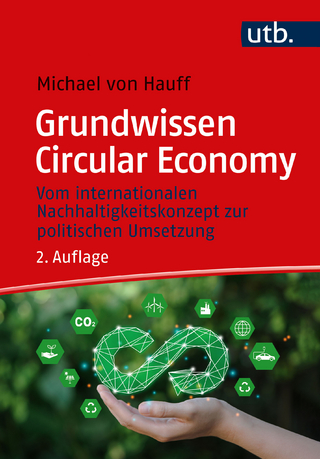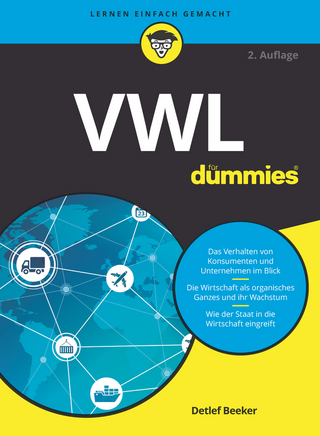
Economics for Business and Management
Not Avail (Verlag)
978-0-273-68549-4 (ISBN)
- Titel erscheint in neuer Auflage
- Artikel merken
Economics for Business and Management is a highly accessible text for students. It introduces the key principles of microeconomics and macroeconomics and applies them to a wide variety of situations encountered by decision makers. The book emphasises the economic perspectives needed to understand the various functional and strategic areas of business and management. Detailed consideration is also given to the political, legal, demographic, socio-cultural, ethical and environmental dimensions which characterise the business environment in which decision makers must operate. Written for 1st year undergraduate courses on economics, with a business or management focus.
INTRODUCTION: USING THIS BOOK PART ONE: MICRO BUSINESS ENVIRONMENT 1. Markets and Resource Allocation Wants, limited resources and choice Demand curves and functions Supply curves and functions Price determination Changes in market price and quantity Resource allocation in different economic systems Key Terms Key Points Assessment Practice Case Study 1.1: Death of the CD! Case Study 1.2: Dyson relocates production to South East Asia Case Study 1.3: Consumer tastes and the Atkins Diet Case Study 1.4: The drug war Case Study 1.6: Fulfilling the plan 2. Demand, Revenue and Consumer Behaviour Price elasticity of demand (PED) Price elasticity of demand (PED) and revenue Total, average and marginal revenue PED and tax incidence Other elasticities of demand 'Veblen effect' and consumer behaviour Consumer surplus Utility and consumer behaviour Key Terms Key Points Assessment Practice Case Study 2.1: Channel Tunnel revenues collapse Case Study 2.2: Taxing French smokers Case Study 2.3: Tobacco smuggling, price elasticity of demand and tax revenue Case Study 2.4: Transport and elasticities of demand Case Study 2.5: 'Top-up fees' and the 'Veblen effect' Case Study 2.6: What is time worth? Case Study 2.7: Changing tastes over time 3. Supply, Production and Cost The factors of production Combining factors of production: the laws of return Costs of production: short run Costs of production: long run Deciding whether to produce in the short run and the long run Price elasticity of supply (PES) Outsourcing and cost Governemnts, location and cost Producer surplus Key Terms Key Points Assessment Practice Case Study 3.1: Theatre costs in the West End Case Study 3.2: Head Office - some easy economies? Case Study 3.3: Scale economies in the skies Case Study 3.4: Outsourcing, production and costs Case Study 3.5: Low-cost goods rule out Britain 4. Business Organisation, objectives and behaviour Types of business organisation Business objectives: maximising Business objectives: non-maximising behaviour Does firm objective matter? Profit, ethics and the environment Business behaviour Corporate governance Product life cycle Key Terms Key Points Assessment Practice Case Study 4.1: Partnership or Ltd company? Case Study 4.2: The rise of shareholder power Case Study 4.3: Brand value and social responsibilty Case Study 4.4: Crisis at Parmalat 5. Firm Size, Mergers and the 'public interest' Small to medium-sized enterprises (SMEs) Small firm survival Small firms and the UK economy Growth in firm size Mergers: who benefits? Types of merger activity Explanantions of merger activity Demerging Mergers and the public interest Key Terms Key Points Assessment Practice Cast Study 5.1: Alternative Investment Market (AIM) Case Study 5.2: Mergers - for managers or shareholders Case Study 5.3: AOL and Time Warner merger Case Study 5.4: Demergers boost value 6. Market Structures Perfect Competition Contestable market theory Monopoly Monopolistic competition Oligopoly Key Terms Key Points Assessment Practice Case Study 6.1: Perfect competition and the Internet Case Study 6.2: New entry and profit rates Case Study 6.3: Cartels and collusion Case Study 6.4: Price discrimination in pharmaceuticals 7. Labour and other Factor Markets Factor payments and derived demand Occupational differences in wages and employment Imperfectly competitive labour markets UK labour marker regulations EU Social Chapter Work-life balance Gender and ageism Transfer earnings and economic rent Key Terms key Points Assessment Practice Case Study 7.1: Pop idols Case Study 7.2: Concerns over the NMW Case Study 7.3: Working hours in France Case Study 7.4: Flexible working - opportunity or threat 8. Market Failure: Regulation and Competition Types of market failure Correcting 'market failures' Regulation Deregulation and privatisation Regulation of privatisation companies UK competition policy EU competition policy Key Terms Key Points Assessment Practice Case Study 8.1: The London Congestion Charge Case Study 8.2: Town bought by power company Case Study 8.3: Tighter rules help to lift SIG sales Case Study 8.4: OFT loses power in merger decisions Case Study 8.5: Ryanair and Charleroi PART TWO: MACRO BUSINESS ENVIRONMENT 9. National Income Determination National income National income: definitions and measurement National income data: international comparisons Components of the circular flow Equilibrium in the circular flow: W/J approach Equilibrium in the circular flow: 45- diagram approach Equivalence of the two approaches Changes in national income National income multiplier Inflationary and deflationary gaps Key Terms Key Points Assessment Practice Case Study 9.1: GDP, technical progress and living standards Case Study 9.2: Quality of life in developing countries Case Study 9.3: China's $29 test Case Study 9.4: Consumer behaviour and indebtedness Case Study 9.5: The multiplier and the London Olympic bid 10. Government Policies: Instruments and objectives Fiscal policy Taxation Government Expenditure Fiscal policy and stabilisation Monetary policy Aggregate demand and aggregate supply analysis Inflation Employment and unemployment Balance of payments Exchange rate Economic Growth Key Terms Key Points Assessment Practice Case Study 10.1: German hyperinflation Case Study 10.2: Global unemployment hits record high Case Study 10.3: Disappearing oil Case Study 10.4: Exchange rates, lattes and burgers 11. Demographic and Social Environment Demographic patterns and trends Action to diffuse the 'demographic time-bomb' Socio-cultural patterns and trends Lifestyles and social attitudes Business implications of demographic and social changes Key Terms Key Points Assessment Practice Case Study 11.1: Carry on working! Case Study 11.2: Catalogue shopping and social class Case Study 11.3: Fast goods for fast lifestyles Case Study 11.4: Life changes everything Case Study 11.5: 'Grey market' on the rise Case Study 11.6: Neighbourhood takes over from occupation 12. Political, legal, ecological and technological environment Political environment Legal environment Ecological environment Technological environment Key Terms Key Points Assessment Practice Case Study 12.1: Freight companies pay for security threat Case Study 12.2: Political risk for business in Russia Case Study 12.3: Directive on tyre disposal Case Study 12.4: The green consumer Case Study 12.5: Environmental sustainability sells Case Study 12.6: The picture gets brighter 13. Functions of management: domestic business environment Marketing Marketing mix Human resource management Accounting and management Key Terms Key Points Assessment Practice Case Study 13.1: The 'no brow' consumer Case Study 13.2: HRM and the Royal Bank of Scotland Case Study 13.3: Why accounting standards matter! 14. International Business Environment The internationalisation process International business environment Multinational enterprise (MNE) International human resource management (IHRM) International marketing International marketing mixNorerica East and South East Asia International institutions and international business Free trade and government protectionism Key Terms Key Points Assessment Practice Case Study 14.1: Internationalisation of Portuguese firms Case Study 14.2: IHRM and cultural characteristics Case Study 14.3: 'IKEA - flat pack success!' Case Study 14.4: Bilateral trade treaties are a sham Case Study 14.5: Durex in China 15. Strategies in a globalised business environment Strategic frameworks for corporate activity SWOT and PESTLE analyses Porter's Five Forces analysis Portfolio analysis National strategic perspectives Globalisation and strategic options for MNEs Strategic joint ventures and alliances Case materials: corporate strategic responses to global forces Key Terms Key Points Assessment Practice Case Study 15.1: Starbuck's strategic development Case Study 15.2: IKEA and growth strategies Case Study 15.3: Outsourcing: opportunity or threat! Case Study 15.4: Coca-Cola and Nestle combine 16. Case Studies: Leisure, Hospitality and Sports Sectors Changing economic structure The particular nature of services Leisure sector Hospitality sector Sports sector Key Terms Key Points Assessment Practice Case Study 16.1: GDS and airlines Case Study 16.2: Rock and Rollers just keep on rocking Case Study 16.3: Cinema going in the UK Case Study 16.4: Basketball and shoes APPENDIX 1: INDIFFERENCE CURVES, BUDGET LINES AND THE 'LAW OF DEMAND' Indifference maps Deriving the demand curve: indifference analysis Imperfect information and loss of consumer welfare APPENDIX 2: ISOQUANTS, ISOCOSTS AND ECONOMIC EFFICIENCY Isoquants Isocost lines Economic efficiency REFERENCES ANSWERS TO CHECKPOINTS AND ACTIVITIES
| Erscheint lt. Verlag | 10.11.2004 |
|---|---|
| Sprache | englisch |
| Maße | 188 x 248 mm |
| Gewicht | 1308 g |
| Themenwelt | Wirtschaft ► Volkswirtschaftslehre |
| ISBN-10 | 0-273-68549-X / 027368549X |
| ISBN-13 | 978-0-273-68549-4 / 9780273685494 |
| Zustand | Neuware |
| Haben Sie eine Frage zum Produkt? |
aus dem Bereich



